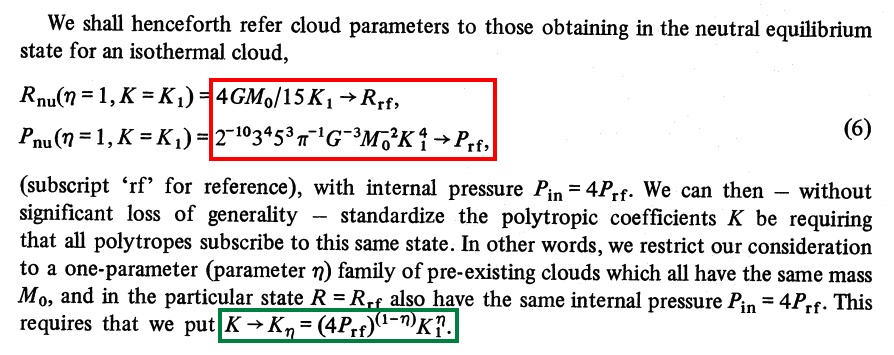Difference between revisions of "User:Tohline/SSC/Structure/BonnorEbert"
(→Summary of Analytic Results: Insert isothermal virial result) |
(→Summary of Analytic Results: Place holder for analytic n = 5, top table) |
||
| Line 96: | Line 96: | ||
</td> | </td> | ||
<td align="center"> | <td align="center"> | ||
-- | |||
</td> | </td> | ||
<td align="center"> | <td align="center"> | ||
-- | |||
</td> | </td> | ||
<td align="center"> | <td align="center"> | ||
<math>\biggl | <math>\biggl( \frac{\bar{c_s}^4}{GP_e} \biggr)^{1/2}</math> | ||
</td> | </td> | ||
</tr> | </tr> | ||
Revision as of 17:25, 22 October 2012

|
|---|
| | Tiled Menu | Tables of Content | Banner Video | Tohline Home Page | |
Mass Upper Limits
Virial Equilibrium
Virial equilibrium explained elsewhere
Polytropes Embedded in an External Medium
Polytropes embedded in an external medium
Summary of Analytic Results
| Example: Specify <math>c_s</math> and <math>P_e</math> | |||||||
|
<math>~n</math> |
<math>\eta = 1+1/n</math> |
<math>M_\mathrm{max}</math> |
<math>R_\mathrm{eq}</math> |
||||
|
<math>\alpha_\mathrm{virial}</math> |
<math>\alpha_\mathrm{DHB}</math> |
<math>\mathrm{scale}</math> |
<math>\alpha_\mathrm{virial}</math> |
<math>\alpha_\mathrm{DHB}</math> |
<math>\mathrm{scale}</math> |
||
|
<math>\infty</math> |
1 |
<math>\biggr(\frac{3^4 \cdot 5^3}{2^{10} \pi}\biggr)^{1/2} </math> |
-- |
<math>\biggl[ \frac{c_s^8}{G^3 P_e}\biggr]^{1/2}</math> |
<math>\biggl(\frac{3^2 \cdot 5}{2^6\pi} \bigg)^{1/2}</math> |
-- |
<math>\biggl( \frac{c_s^4}{GP_e} \biggr)^{1/2}</math> |
|
5 |
6/5 |
-- |
<math>\biggl( \frac{1}{2} \biggr)^{3/10} \biggl( \frac{3^7}{2^8 \pi} \biggr)^{1/2}</math> |
<math>\biggl[ \frac{\bar{c_s}^8}{G^3 P_e}\biggr]^{1/2}</math> |
-- |
-- |
<math>\biggl( \frac{\bar{c_s}^4}{GP_e} \biggr)^{1/2}</math> |
| Example: Specify <math>M</math> and <math>c_s</math> | |||||||
|
<math>~n</math> |
<math>\eta = 1+1/n</math> |
<math>(P_e)_\mathrm{max}</math> |
<math>R_\mathrm{eq}</math> |
||||
|
<math>\alpha_\mathrm{virial}</math> |
<math>\alpha_\mathrm{DHB}</math> |
<math>\mathrm{scale}</math> |
<math>\alpha_\mathrm{virial}</math> |
<math>\alpha_\mathrm{DHB}</math> |
<math>\mathrm{scale}</math> |
||
|
<math>\infty</math> |
1 |
<math>\biggr(\frac{3^4 \cdot 5^3}{2^{10} \pi}\biggr)</math> |
-- |
<math>\biggl[ \frac{c_s^8}{M^2 G^3}\biggr]</math> |
<math>\frac{2^2}{3\cdot 5} </math> |
-- |
<math>\biggl( \frac{GM}{c_s^2} \biggr) </math> |
|
5 |
6/5 |
-- |
<math>\biggl( \frac{1}{2} \biggr)^{3/5} \biggl( \frac{3^7}{2^8 \pi} \biggr)</math> |
<math>\biggl[ \frac{\bar{c_s}^8}{M^2 G^3}\biggr]</math> |
-- |
<math>\frac{2^{2}}{3^2} </math> |
<math>\biggl( \frac{GM}{\bar{c_s}^2} \biggr) </math> |
Bonnor-Ebert Limiting Mass
Here we will refer to the original works of Ebert (1955, ZA, 37, 217) and Bonnor (1956, MNRAS, 116, 351) .
In his study of the "global gravitational stability [of] one-dimensional polytropes," Whitworth (1981, MNRAS, 195, 967) normalizes (or "references") various derived mathematical expressions for configuration radii, <math>R</math>, and for the pressure exerted by an external bounding medium, <math>P_\mathrm{ex}</math>, to quantities he refers to as, respectively, <math>R_\mathrm{rf}</math> and <math>P_\mathrm{rf}</math>. The paragraph from his paper in which these two reference quantities are defined is shown here:
In order to map Whitworth's terminology to ours, we note, first, that he uses <math>M_0</math> to represent the spherical configuration's total mass, which we refer to simply as <math>M</math>; and his parameter <math>\eta</math> is related to our <math>~n</math> via the relation,
<math>\eta = 1 + \frac{1}{n} \, .</math>
Hence, Whitworth writes the polytropic equation of state as,
<math>P = K_\eta \rho^\eta \, ,</math>
whereas, using our standard notation, this same key relation is written as,
<math>~P = K_\mathrm{n} \rho^{1+1/n}</math> ;
and his parameter <math>K_\eta</math> is identical to our <math>~K_\mathrm{n}</math>.
According to the second (bottom) expression identified by the red outlined box drawn above,
<math> P_\mathrm{rf} = \frac{3^4 5^3}{2^{10} \pi} \biggl( \frac{K_1^4}{G^3 M^2} \biggr) \, , </math>
and inverting the expression inside the green outlined box gives,
<math> K_1 = \biggl[ K_n (4 P_\mathrm{rf})^{\eta - 1} \biggr]^{1/\eta} \, . </math>
Hence,
<math> P_\mathrm{rf} = \frac{3^4 5^3}{2^{10} \pi} \biggl( \frac{1}{G^3 M^2} \biggr)\biggl[ K_n (4 P_\mathrm{rf})^{\eta - 1} \biggr]^{4/\eta} \, , </math>
or, gathering all factors of <math>P_\mathrm{rf}</math> to the left-hand side,
<math> P_\mathrm{rf}^{(4-3\eta)} = 2^{-2(4+\eta)} \biggl( \frac{3^4 5^3}{\pi} \biggr)^\eta \biggl[ \frac{K_n^4}{G^{3\eta} M^{2\eta}} \biggr] \, . </math>
Analogously, according to the first (top) expression identified inside the red outlined box,
<math> R_\mathrm{rf} = \frac{2^2 GM}{3\cdot 5 K_1} = 2^{2/\eta} \biggl( \frac{GM}{3\cdot 5}\biggr) K_n^{-1/\eta} P_\mathrm{rf}^{(1-\eta)/\eta} ~~~~\Rightarrow~~~~ R_\mathrm{rf}^\eta = \frac{2^{2}}{K_n} \biggl( \frac{GM}{3\cdot 5}\biggr)^\eta P_\mathrm{rf}^{(1-\eta)} \, . </math>
Related Wikipedia Discussions

|
|---|
|
© 2014 - 2021 by Joel E. Tohline |
